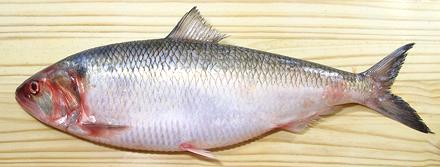 [Alosa sapidissima]
[Alosa sapidissima]
This is an amazingly delicious fish - for experienced fish eaters, as will be explained. It is native to the east coast of North America, from the St Lawrence river, Newfoundland and Nova Scotia, south to central Florida, but less common south of Virginia. Some are also found on the north coast of the Gulf of Mexico. Due to introduction, it is now also found from the south coast of Alaska to The Mexican Border of California, and along the Russian Kamchatka Peninsula. It can grow to 30 inches and 12 pounds, but the photo specimen, purchased from an Asian market in Los Angeles, was 20-1/4 inches and 3 pounds 3 ounces - still pretty big for a herring. Unfortunately, it was sold already scaled, so it should look more silvery. This fish is more closely related to European shad than to other North American shad. This fish is not considered endangered, IUCN Red Listed LC (Least Concern).
More on the Herring Family.
This is considered so excellent an eating fish it is often served with no more than a sprinkling of vinegar or lemon juice. The main flesh is off-white with an enjoyable, not quite mild flavor. There is a very thick dark streak down the center under the skin which has a much stronger but not at all offensive flavor. You will also likely be eating the skin, which has a strength of flavor in between the two.
I very much like fillets of this fish poached, or just powdered with rice flour and fried. Use only a very light, mildly acidic sauce - heavier sauces will clash with the fish's flavor. Do not batter this fish. Not only will that mask the flavors, it will make the spines very difficult to deal with. This fish could be baked or steamed, but it is not at all good for soup due to the spines.
Yes, spines. The flesh of this fish is as infested with thread-like branching spines as any carp. They cannot be removed by any means and must be dealt with on the plate and in the mouth. It is for fish like this that even strict Victorian table manners allowed fish bones to be removed from the mouth - but nothing else.
I always eat fish with chopsticks, which gives me great precision in disassembling them on the plate and eliminating spines and the like. Do not cut fillets of this fish into segments less than about 3 inches long. Short pieces will make the spines considerably more difficult to deal with.
Use your kitchen shears to cut away the stiff skutes at the bottom edge of the fillet. At this point, you'll notice the whole fillet is prickly on the inside due to the spines. There's nothing you can do about that, they're in hard and cannot be pulled, and there are far too many of them anyway.